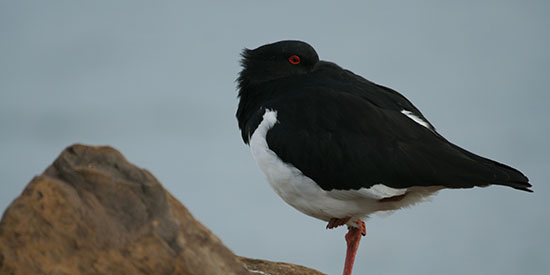Study shows big-billed birds spend more time snuggling in against the cold
Media releaseBigger isn't always better - at least not in the bird kingdom, with new Deakin University research finding that the larger a bird's bill the longer they spend trying to snuggle it in against the cold.
Ecologist Matthew Symonds, Deputy Director at the Centre for Integrative Ecology in Deakin's School of Life and Environmental Sciences, and team leader on the research, said the study examined the "backrest" behaviour of birds - where they turn their heads to the back and tuck their beaks underneath their feathers when they are resting.
"While people have long assumed that birds exhibited this behaviour to protect themselves against the cold, no one had actually rigorously studied it. We found that they were indeed using backrest to try to keep warm, because they do it more when it gets colder," Dr Symonds said.
"But the surprising thing we discovered was that the birds with bigger bills used this behaviour more, and over longer periods of time. In fact, they continued to use the behaviour more even as the weather warmed."
The study looked at nine species of shorebirds ranging from the largest comparative beak size, 9.2cm, found on the red-necked avocet, to the smallest, 3.4cm, found on the masked lapwing.
The field research was carried out by a Deakin honours student, Julia Ryeland, who observed the birds roosting over a six month period along the coastal flats around Port Phillip and Westernport Bays near Melbourne in southern Victoria.
Ms Ryeland said hundreds of hours of footage of shorebirds was collected under temperatures from around 10 to more than 40 degrees.
"When we looked at the footage, we found the red-necked avocet, which has the longest relative bill length, had the highest use of the backrest posture, while the masked lapwing, with the smallest relative bill length, used it the least," she said.
Dr Symonds said the findings had a significant implication for how bigger-billed birds spent their time.
"This means that while these birds have developed larger beaks to help them forage for food, it actually has a negative side effect in that they need to spend more time keeping this equipment protected from the cold," he said.
"This then lessens their time available for things like food gathering and keeping an eye out for predators. It’s an unexpected cost of having a larger bill."
Dr Symonds said bills were a significant area of heat loss for birds and his previous research had shown that birds in colder climates had evolved to have smaller beaks to mitigate this effect.
"For a really large bird like the toucan the bill accounts for about 40 percent of body surface area and 60 percent of the heat loss at rest," he said.
"So this likely explains why birds are so keen to keep their bills tucked in."
The paper by the Deakin University team, "Bill size mediates behavioural thermoregulation in birds", was published online in the journal Functional Ecology today.

